Lawson M.V. Finite Automata
Подождите немного. Документ загружается.

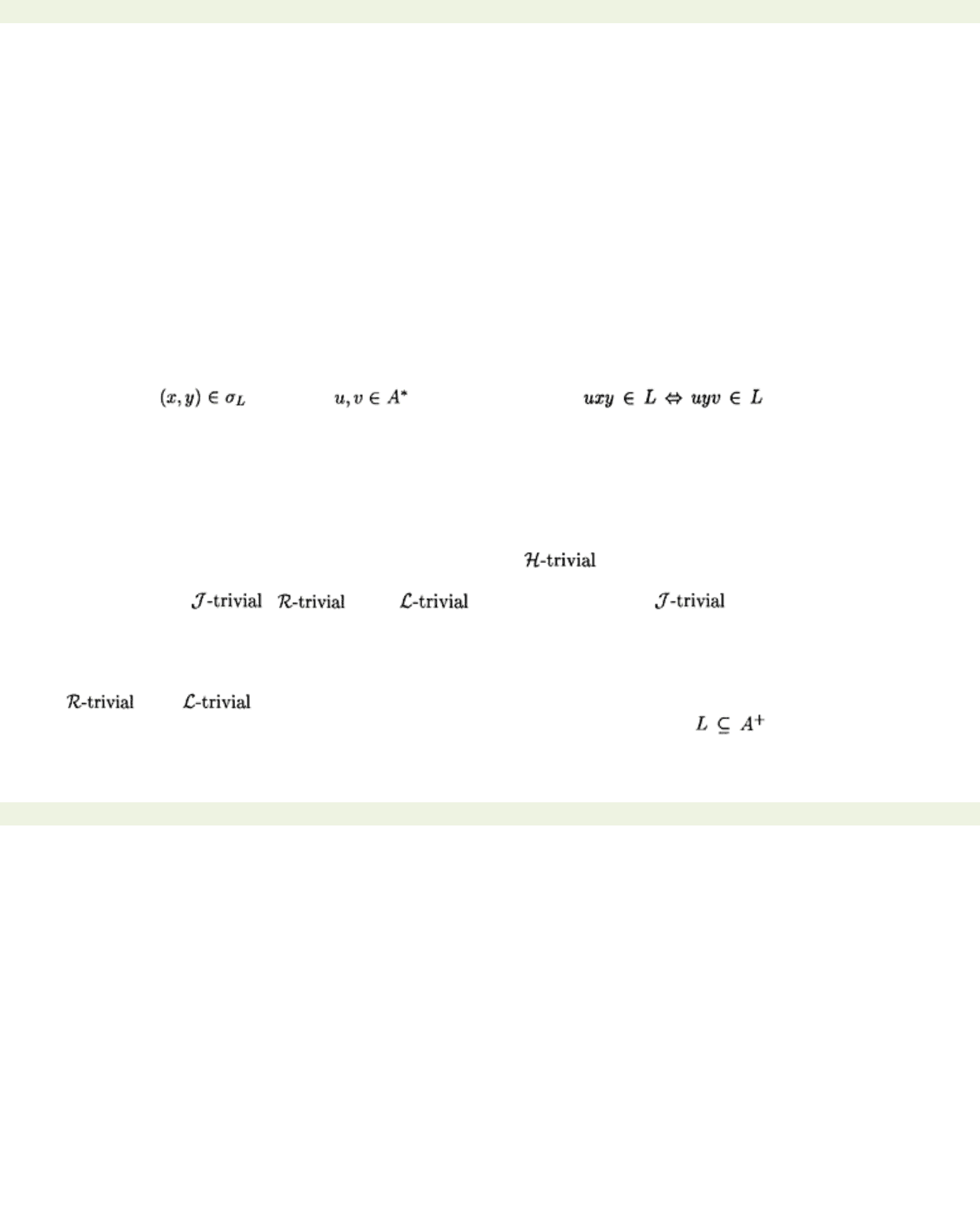
< previous page page_277 next page >
Page 277
particularly given what we said in the second paragraph of the Remarks on Chapter 4. However more
mathematical motivation for the definition can be found in Lallement [77] (pp 165–169).
The Variety Theorem provides the framework for talking about recognisable languages and finite
monoids. It says that if you have a pseudovariety of finite monoids then there will be an associated
variety of languages, although it will not tell you what these languages look like; that involves extra
work and depends on the properties of the pseudovariety of monoids in question. Likewise, if you have a
variety of languages, the Theorem tells us that there is an associated pseudovariety of finite monoids,
but again it will not tell us what they look like; you have to do extra work. For example,
Schützenberger’s Theorem can be interpreted in terms of the Variety Theorem: it identifies the
pseudovariety of monoids that correspond to the variety of star-free languages as being the
pseudovariety of aperiodic monoids.
In this chapter, we set up a correspondence between pseudovarieties of finite monoids and varieties of
languages. This correspondence can also be extended to deal with semigroups rather than monoids. A
pseudovariety of semigroups
is a collection of semigroups closed under subsemigroups, homomorphic
images, and finite products of semigroups. In this context, a language
L
is a subset of
A
+ not
A
*. The
syntactic semigroup
of
L,
denoted
S(L),
is defined to be
A
+/
σL
where
σL
is the congruence defined on
A
+ as follows: iff for all (sic) we have that . The results we
proved about syntactic monoids generalise to syntactic semigroups.
Varieties of languages
in this
context are defined as before except that (VL3) is replaced by homomorphisms between free
semigroups. These varieties are sometimes called +-
varieties
to distinguish them from the varieties of
languages I defined in the text that are sometimes called *-
varieties
. The Variety Theorem can then be
extended to give a correspondence between pseudovarieties of finite semigroups and +-varieties of
languages.
The Variety Theorem is, in effect, a research program, and as such it has been enormously fruitful. We
have seen that the finite aperiodic monoids are just the
ones and, of course, Schützenberger’s
Theorem tells us that the associated languages are the star-free ones. Similar analyses have also been
carried out on the
, , and finite monoids. The monoids correspond to
the class of ‘piecewise testable languages.’ These are the languages in the Boolean algebra generated
by languages of the form
A
*
a
1
A
*
a
2
…A
*
anA
* where the
ai
are letters; this means that every piecewise
testable language can be described by Boolean combinations of such languages. This is a deep result
first proved by Simon [121], and described in Pin [103]. A more recent account can be found in [61].
The
and monoids are much easier to handle. See Pin, again, for a nice account [103].
An important class of languages was introduced in Section 2.4. A language is said to be
locally
testable
iff it is in the Boolean algebra generated by languages of the form
uA
*
, A
*
v,
and
A
*
wA
*. This
variety of languages was first identified as promising by McNaughton and Papert [88]. The characteri-
< previous page page_277 next page >

< previous page page_278 next page >
Page 278
sation of the corresponding pseudovariety of monoids is difficult and is due to McNaughton [89],
Zalcstein [137], and Brzozowski and Simon [21]: a language
L
is locally testable iff its syntactic
semigroup
S
=
S(L)
has the following property: for each idempotent the local monoid
eSe
is a
semilattice. A sketch of the proof of this result is given by Perrin [100]. The ramifications of this result
were unexpected. Through work of Straubing [128] and Tilson [133], it became clear that the study of
certain kinds of pseudovarieties depended on ‘category theory,’ where, roughly, this theory is a
generalisation of both graph theory and monoid theory. A recent paper on locally testable languages is
[134].
Another strand in the relationship between semigroups and languages, which I have only been able to
touch on in this book, concerns the sequential functions defined at the end of Chapter 1. It is interesting
to try to decompose such functions into series or parallel arrangements of simpler sequential functions.
The theory that tells us whether and how this is possible is intimately connected with the theory of
pseudovarieties of monoids and semigroups. This theory is described in Chapter VI of [40].
If you want to find out more about research on finite monoids and regular languages, there are a
number of places to start. Howie’s book [67] covers roughly the same material as mine. Pin’s book [103]
is probably the obvious next text to read, since it overlaps with my book, but then goes considerably
further. Useful surveys of the field are [105] and [15]. The collections [45] and [56], and the paper
[125] will give you some idea of the range of work being carried out in this area.
The description of pseudovarieties in terms of equations being ultimately satisfied is replaced in more
advanced work by a description in terms of ‘pseudoidentities’ due to Reiterman [110]. This approach is
described in Jorge Almeida’s advanced book [3].
And to make an end is to make a beginning.
T.S.Eliot
< previous page page_278 next page >

< previous page page_279 next page >
Page 279
Appendix A
Discrete mathematics
The aim of this appendix is to sketch out the background you need from discrete mathematics to read
this book. It is not intended to be a replacement for having attended a course or worked through a
book, but it can serve as a detailed synopsis or an
aide-memoire
. There are many good introductions to
discrete mathematics. The book by Johnsonbaugh [71], for example, contains more than enough.
A.1 Logic and proofs
Mathematics is first and foremost about proofs. Human beings are already endowed with reasoning
abilities, even if they are a bit rough-and-ready, so my philosophy on proofs is that the best way to
learn what they are is to try to do them. If you have not met proofs before, then it will take time before
you begin to feel comfortable with them. But the effort is worth it in the depth of understanding gained
as a result. In this section, I will just give you the bare essentials on proofs, and encourage you, even if
you are not familiar with them, to dive in anyway.
It is important to understand at the outset, that in mathematics we only deal in things that are either
true or false: one or other but not both. Sentences such as: ‘To be or not to be?’, ‘Out damn spot!’ and
‘Aaah!’ ask questions, make demands, express emotions, and so on, but are neither true nor false. All
these things play a big role in trying to do mathematics, but are rigorously expunged from the writing of
mathematics. A
statement
is a sentence that is either true or false. Mathematics, once all the human
factors have been wrung from it, is about statements. The goal of mathematics is to determine which
statements are true and which false. As human beings we add the word ‘interesting’ in front of the word
‘statements.’ To show that a statement is false it is enough to find one single example, called a
counterexample,
where the statement is false. To show that a statement is true you have to prove it.
< previous page page_279 next page >

< previous page page_280 next page >
Page 280
Most statements in mathematics take the form: ‘if
P,
then
Q
’ meaning ‘if
P
is true, then
Q
is true.’ We
also say ‘
P
implies
Q
’
,
or ‘
P
is a sufficient condition for
Q,
’ or that ‘
Q
is a necessary condition for
P
.’ We
often write ‘
P Q
.’ The letter
P
stands for the assumptions, and the letter
Q
stands for the conclusions.
The statement ‘
Q P
’ is called the
converse
of the statement ‘
P Q
.’ A statement and its converse say
very different things, and the truth or falsity of one does not imply the truth or falsity of the other. For
example, the statement ‘if
n
is a positive number, then
n
2 is a positive number’ is true, but the
converse, ‘if
n
2 is a positive number, then
n
is a positive number,’ is false, as the counterexample
n
=−1
shows. If ‘
P Q
’ and ‘
Q P
’ are both true, then we write ‘
P Q,
’ which is read ‘
P
if and only if
Q
’
often abbreviated to ‘
P
iff
Q
.’ We also say that ‘
P
is a necessary and sufficient condition for
Q
.’
There are two ways to try to prove a statement of the form ‘if
P,
then
Q
.’ The simplest is called a
direct
proof,
and takes the following form: we write down our assumption
P;
we carry out an argument; we
deduce
Q
. An
argument
consists of things we know to be true, perhaps because they were proved
earlier, or because of a definition, or because of what we are allowed to assume in
P
. In addition, we
can write down statements that are deductions from previous statements in our argument. For example,
if ‘
R
or
S
’ is true and I know that
R
is false then I know that
S
must be true. Little arguments such as
this are often described at the beginning of books on discrete mathematics, but are usually easy to pick
up from working through specific proofs. Unfortunately, direct proofs do not always work and then we
have recourse to what are known as
indirect proofs
. These take the following form: assume that
P
is
true; then for the sake of argument assume that
Q
is
false,
i.e., the reverse of what we want. Then
carry out an argument that leads to an assertion contradicting something we know to be true. Because
assuming
Q
false leads to a contradiction, and because statements are either true or false but not both,
it follows that
Q
must really be true. Most arguments in this book are direct, and many mathematicians
have a bias in favour of direct arguments.
There is one type of direct proof that we often use in this book:
proof by induction
. This works for those
statements
P
whose truth is determined by the truth of a sequence of special cases:
P
(0),
P
(1),
P
(2),…,
that is, to prove
P
is true we have to prove that the statements
P(n)
are true for all natural numbers
n
.
The general form a proof by induction is as follows:
•
Base case:
Check first that
P
(0) is true.
•
Induction hypothesis:
Assume that
P(k)
is true.
•
Deduction:
Use the truth of
P(k)
to establish the truth of
P
(
k
+1); it is at this stage we usually have to
do some work.
•
Conclusion:
Conclude that
P(n)
is true for all
n,
from which it follows that
P
is true, as required.
< previous page page_280 next page >

< previous page page_281 next page >
Page 281
There are a number of variations on this basic pattern. First,
P(n)
may only be true from some number
n
0 onward, in which case the base case above will be ‘check
P(n
0
)
is true.’ Second, we often have to
assume that
P(n
0
),…, P(k)
are
all
true to prove that
P
(
k
+1) is true.
Mathematicians have developed some special terms concerned with proofs. Proved statements are called
propositions
or
theorems
. There is no real agreement on how to use these terms, but a rule of thumb is
that theorems are more important than propositions; that is how I distinguish between them in this
book. A
lemma
is a proved statement that is more useful in proving other results than of particular
interest in itself. A
corollary
is a proved statement that follows almost immediately from a proposition or
theorem. A
conjecture
is a statement that we think is true but do not yet have a proof for (and so could
turn out to be false). The conclusion to a proof is nowadays marked by drawing a box. Older books
mark the ends of proofs by writing ‘q.e.d.,’ which is an abbreviation of the Latin ‘quod erat
demonstrandum,’ meaning ‘that which was to be proved.’ The notion of proving things was due to the
Greeks, which is why the terminology has a classical ring to it.
We prove a wide variety of propositions and theorems in this book, but an important class concern
algorithms. Informally, an
algorithm
is a recipe for doing something. In school, we learn algorithms for
adding, subtracting, multiplying, and dividing numbers. Mathematics is full of algorithms. They are useful
because they tell us how to actually do something rather than just telling us that something exists. Most
often they enable us to write a program to get a computer to do something. Every program is an
implementation of an algorithm, and an algorithm is only an algorithm if it could be implemented by
some computer. However, if I give you an algorithm, how do you know that it does what it says on the
wrapper? This is another role for proofs: proving or verifying that an algorithm is correct. Many of the
proofs in this book do exactly that. I should add that the word ‘algorithm,’ like the word ‘algebra,’ is of
Arabic origin: what the Greeks started the Arabs continued.
Everything I have said applies to writing down proofs, and how to read proofs, it does not tell you how
to find proofs. This is an exercise in creativity as much as logic. The book by Polya [108] contains useful
hints.
A.2 Set theory
The most basic mathematical notion is that of a
set
. This is simply a collection of objects that we wish
to regard as a whole. The members of a set are called its
elements
. We usually, but not invariably, use
capital letters to name sets: such as
A, B,
or
C
or fancy capital letters such as and . The elements
of a set are usually, but not invariably, denoted by lower case letters. If
x is an element of
the set
A
then we write
< previous page page_281 next page >
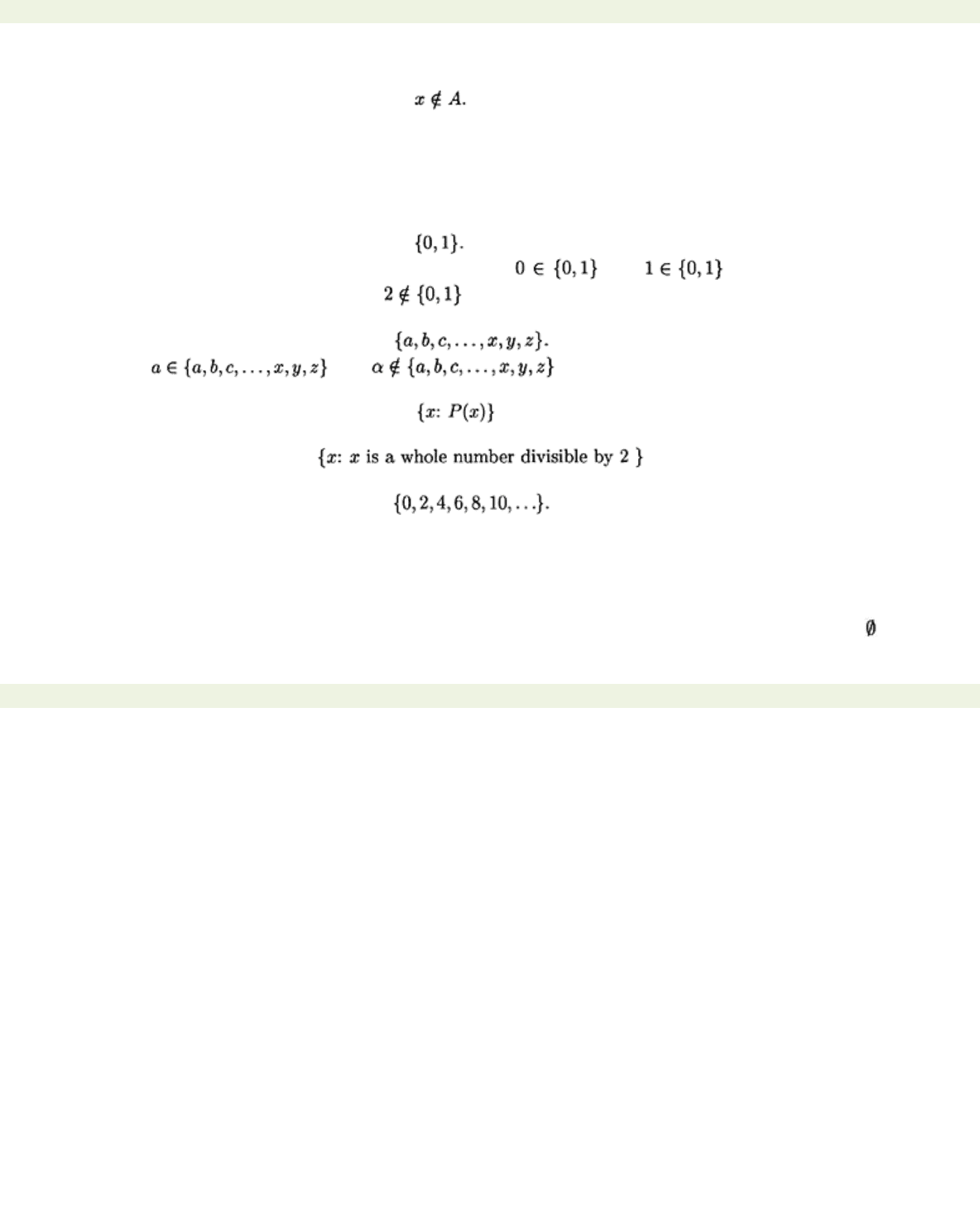
< previous page page_282 next page >
Page 282
and if
x is not an element of
the set
A
then we write
A set is completely defined once we have said what its elements are; there is nothing more to them
than that. If a set has only finitely many elements, then we might be able to list them: this is done by
putting them in ‘curly brackets’ {and}. It is important to remember that order and repetition do not
matter when describing the elements of a set.
Examples A.2.1 Here are two examples of sets.
(1) The set of binary digits (or bits) is
Both 0 and 1 are elements of this set, so we can write
and . However, 2 is not an
element of this set and so we can write
.
(2) The set of all letters in the English alphabet is
We have that
but .
We often describe a set by saying what properties an element must have to belong to the set:
means ‘the set of all things
x
that satisfy the condition
P
.’ For example,
is the set
It is quite possible for a set to contain elements that are themselves sets. For example,
A
=
{{a}, {a, b}}
is a set whose elements are
{a}
and
{a, b},
which both happen to be sets. This is important, because it
means that the notion of set, which at first appears rather simple-minded, is capable of great
elaboration.
Examples A.2.2 Some more examples of sets.
(1) The empty set {}, which is the unique set with no elements. We usually denote this set by
,
a letter
from the Danish alphabet being the first one of the Danish word for ‘empty.’
< previous page page_282 next page >
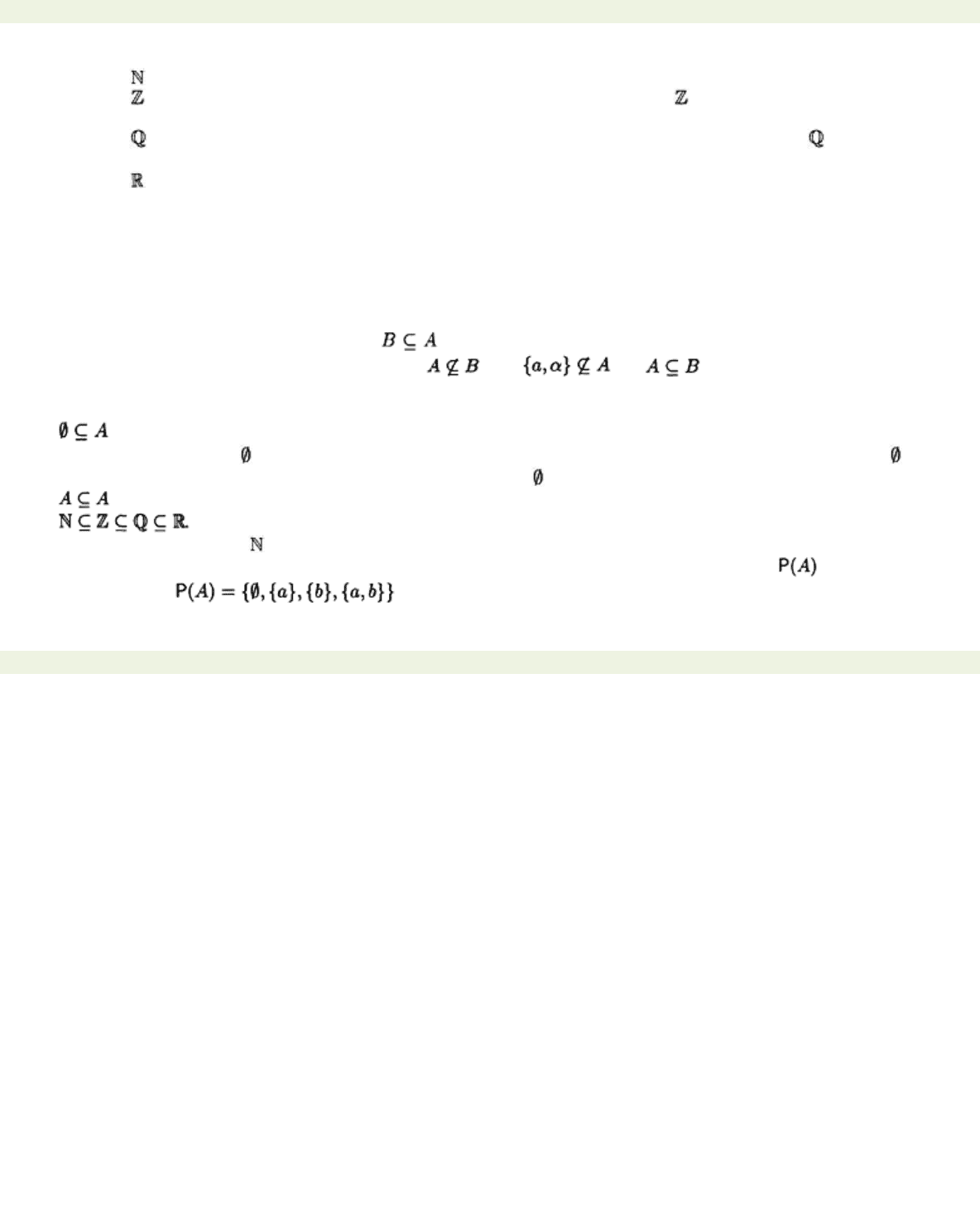
< previous page page_283 next page >
Page 283
(2) The set ={0, 1, 2, 3,…} of all
natural numbers
.
(3) The set ={…, −3, −2, −1, 0, 1, 2, 3,…} of all
integers
. The reason is used to designate this set
is because ‘Z’ is the first letter of the word ‘Zahl’ the German for number.
(4) The set
of all
rational numbers
; i.e., all fractions both positive and negative. Here is used to
designate this set because ‘Q’ is the first letter of the word ‘quotient’.
(5) The set of all
real numbers
; i.e., all numbers that can be represented by decimals with potentially
infinitely many digits after the decimal point.
Notice that in some of the above definitions of sets, I have used ‘…’ to mean ‘and so on in the obvious
way’: if you are going to define a set in this way, you should be pretty certain that the remaining
elements really are obvious; a definition of a set shouldn’t be an intelligence test.
Sometimes it is easy to decide what the elements of a set are and sometimes we need to do a lot of
work: for example, we might need to prove a theorem or apply an algorithm.
If you have a set
A,
then you can form a new set
B
by
choosing
elements from
A
to put in
B
. We say
that
B
is a
subset
of
A,
which is written . For example, if
A
=
{a, b, c, d}
. The set
{a, d}
is a subset
of
A
. If
A
is not a subset of
B,
then we write . So . If and
A
≠
B,
then we say that
A
is a
proper
subset of
B
.
Examples A.2.3 Some inclusions among sets.
(1) for every set
A
. This often surprises people and needs proving. To do this, we need to argue
indirectly. Suppose that were not a subset of
A
. Then there would have to be some element of that
was not an element of
A
. But this is impossible, because is empty.
(2) for every set
A
.
(3)
.
Other familiar subsets of are the set of even numbers, the set of odd numbers, and the set of primes.
All the subsets of a set
A
together form a new set called the
powerset
of
A,
denoted . For example,
if
A
=
{a, b}
then .
There are three basic operations on sets. To define them, let
A
and
B
be sets:
< previous page page_283 next page >
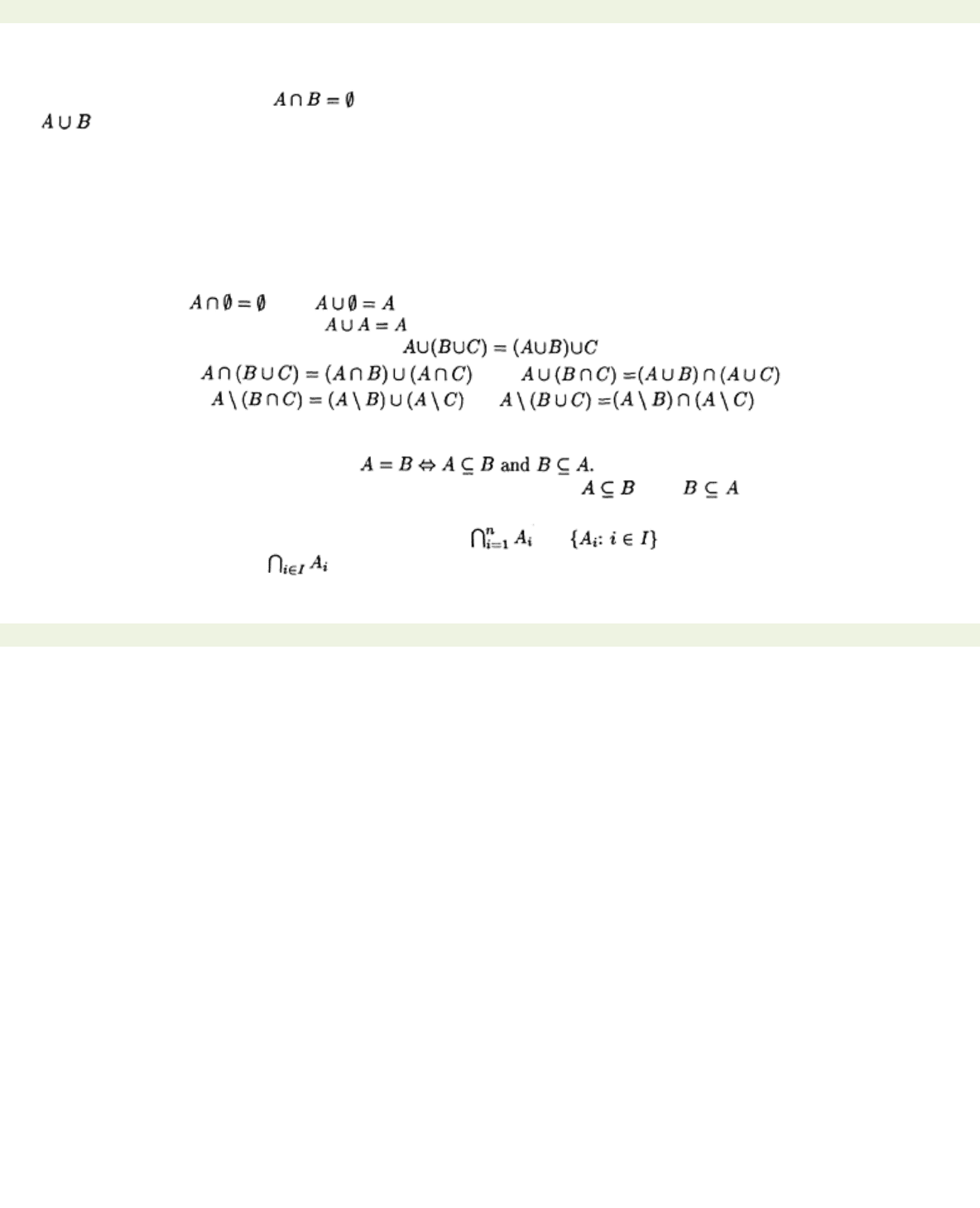
< previous page page_284 next page >
Page 284
•
A
n
B,
the
intersection
of
A
and
B,
is the set of all elements that belong both to
A
and to
B
. If
A
and
B
are a pair of sets such that then they are said to be
disjoint
.
•
,
the
union
of
A
and
B,
is the set of all elements that belong to
A
or to
B
or to both. The word
‘or’ in mathematics always means ‘or both.’ In everyday use, we tend to use the word ‘or’ in an
exclusive sense: ‘Would you like this bar of delicious Belgian chocolate, or would you like this slice of
apple strudel with whipped cream?’; I’m expecting you to make a decision, not to eat both.
•
A
\
B,
read
‘A minus B,’
also called
relative complement,
the set of all elements that belong to
A
but not
to
B
.
These operations are called
Boolean operations
after George Boole.
Notation Throughout this book, union is also denoted by + when refering to unions of languages.
Set operations have a number of important properties. Let
A, B,
and
C
be any sets:
•
Empty set laws:
and .
•
Idempotency laws: A
n
A
=
A
and .
•
Associative laws: A
n
(B
n
C)
=
(A
n
B)
n
C
and .
•
Distributive laws:
and .
•
De Morgan’s laws:
and .
To prove these laws hold, we often use the following standard method. For two sets
A
and
B,
we have
that:
Thus to prove that
A
=
B,
it is enough to prove separately that and .
If there are several sets
A
1
,…, An,
then the intersection
A
1n
…
n
An
is unambiguous because of
associativity. This intersection can also be written
. If is a set of sets, then their
intersection can be written
. Similar comments apply to union. Observe that forming infinite
intersections and infinite unions is mathematically unproblematical.
< previous page page_284 next page >
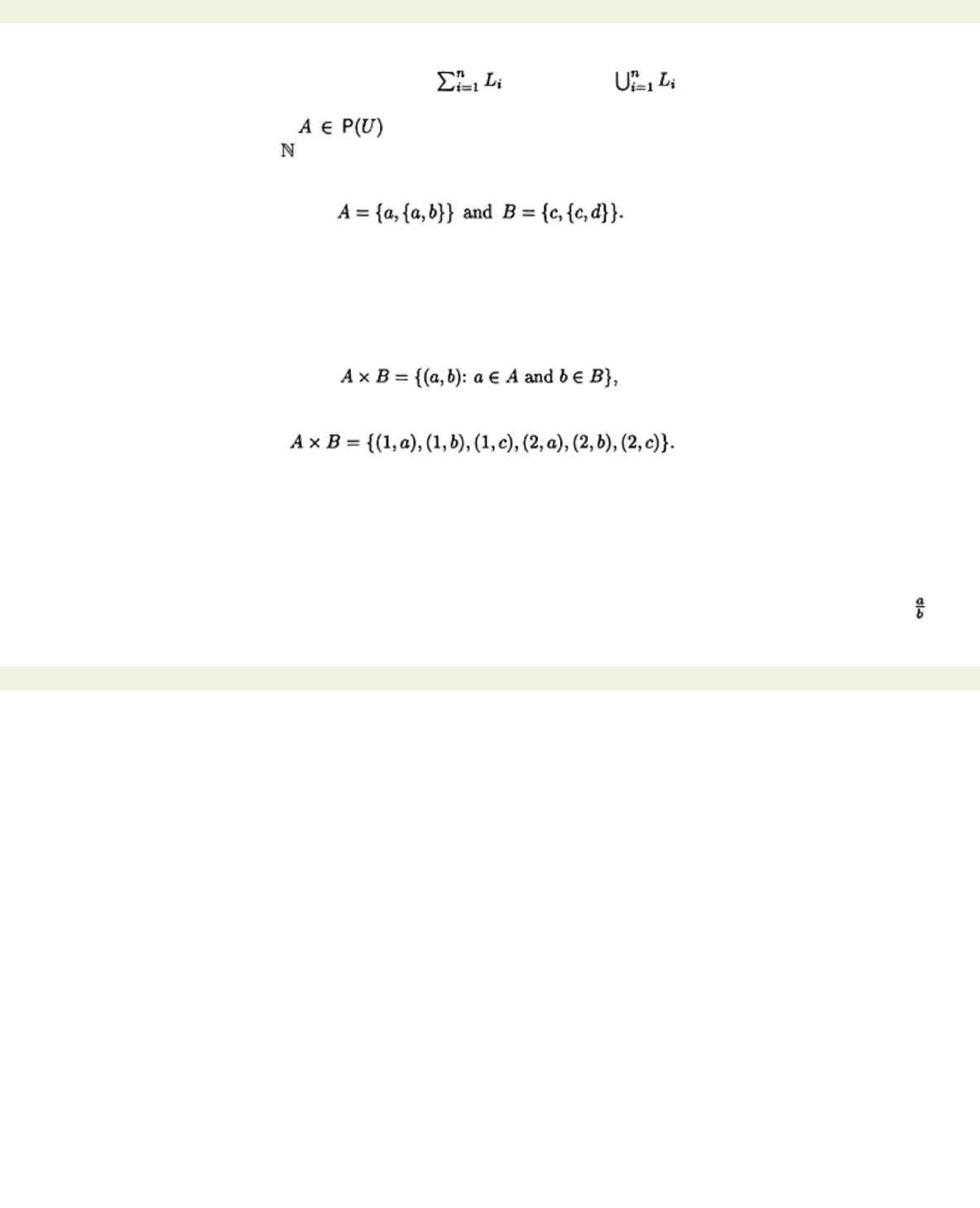
< previous page page_285 next page >
Page 285
Notation In the case of languages
Li,
I write rather than in this book.
It often happens that we are interested in a fixed set
U
and its subsets. In this context,
U
is called
(rather grandly) a
universe
. If then
A′
=
U
\
A
is called the
complement
of
A
. For example, if we
take as our universe the set , and let
A
be the set of even numbers, then
A'
is the set of odd numbers.
I mentioned above that we can form sets whose elements are themselves sets. This is where the real
power of set theory manifests itself. For example, consider the two sets
When is
A
=
B
? It is not hard to check that we need
a
=
c
and
b
=
d
. We define
(a, b)={a, {a, b}},
called
an
ordered pair
. Whereas
{a, b}
contains the elements
a
and
b
in no particular order,
(a, b)
contains the
elements
a
and
b
in the given order. Thus set notation, which is essentially un-orderly, can be used to
define the orderly. The element
a
is called the
first component
and the element
b
is called the
second
component
. We can also define
ordered triples,
which look like
(a, b, c),
and more generally
ordered n-
tuples,
which look like
(a
1
,…, an)
. Ordered
n
-tuples are also called
lists
or
finite sequences
.
If
A
and
B
are sets, then the set
A
×
B,
called the
product of A by B,
is defined to be the following set:
the set of all ordered pairs where the first component comes from
A
and the second component comes
from
B
. For example, if
A
={1, 2} and
B
=
{a, b, c},
then
More generally we can define
A
×
B
×
C
to consist of all ordered triples where the first component comes
from
A,
the second from
B,
and the third from
C
. Yet more generally we can define
A
1×
…
×
An
to
consist of all
n
-tuples where the
i
th component comes from
Ai
.
If you want to find out more about set theory, then I recommend Paul Halmos’ book [59].
A.3 Numbers and matrices
I do not use numbers very much in this book, but there are some properties we shall need. If
a
and
b
are integers then we say that
‘a divides b,’
written
a
|
b,
if
a
=
bq
for some integer
q
. The symbol ‘|’ is just
a replacement for the word ‘divides,’ it does not mean the same as
a
/
b,
which is either the fraction or
means ‘
a
divided by
b
.’ If
a
and
b
are natural numbers and
d
is a number that
< previous page page_285 next page >

< previous page page_286 next page >
Page 286
divides them both then we call
d
a
common divisor
of
a
and
b
. The largest common divisor of
a
and
b
is
called their
greatest common divisor
. If the greatest common divisor of
a
and
b
is 1, then
a
and
b
are
said to be
coprime
.
If
and
a
>0, then we can find integers
r, q
such that
b
=
aq
+
r
where 0≤
r
<
a
. This result is called
the
Remainder Theorem
. An
even number
is an integer
n
that can be written
n
=2
m
for some integer
m
.
An
odd number
is an integer
n
that can be written
n
=2
m
+1 for some integer
m
.
The Remainder Theorem is the basis for a fast algorithm, called
Euclid’s algorithm,
for computing the
greatest common divisor of two natural numbers. This algorithm can be used to prove the following
theorem:
a
and
b
are coprime if and only if there are integers
x
and
y
such that 1=
xa
+
yb
.
A natural number
p
is said to be
prime
if it satisfies
two
conditions: first,
p
≥2 and second, the only
divisors of
p
are 1 and
p
itself. Notice that 1 is
not
prime. This exception is for technical reasons. The
only even prime number is 2. There are infinitely many primes, a theorem first proved by Euclid over
2000 years ago. The proof goes as follows: let
p
1
,…, pn
be the first
n
prime numbers. Put
N
=
(p
1
…
pn)
+1. Then there are two possibilities. Either
N
is itself prime or if not it must be divisible by a prime.
If
p
is a prime dividing
N,
then it must be bigger than
pn,
because dividing
N
by any of the primes
p
1
,
…, pn
leaves remainder one. In either event, we have found a prime bigger than
pn
. It follows that
there can be no largest prime, and so there are infinitely many primes.
I use matrices in one or two places for convenience. A
matrix
is just a rectangular array consisting of
m
rows and
n
columns of
elements
or
entries
. We speak of an
m
×
n
-matrix. If
m
=
n
we say the matrix is
square
. If
m
=1 we say the matrix is a
row matrix,
if
n
=1 we say the matrix is a
column matrix
. Matrices
are usually denoted by upper case letters
A, B,…,
sometimes in bold. If
A
is an
m
×
n
-matrix then the
element in the
i
th row and
j
th column, where 1≤
i
≤
m
and 1≤
j
≤
n,
is denoted
Aij
. If
A
is a square matrix,
then the entries
Aii
are said to form the
leading diagonal
of
A
. Let
A
be an
m
×
n
-matrix. The
transpose
AT
of
A
is the
n
×
m
-matrix defined by interchanging rows and columns of
A
. Thus
(AT)ji
=
Aij
. A matrix
A
is
symmetric
if
AT
=
A
.
Let
A
be an
m
×
n
-matrix and let
B
be an
n
×
p
-matrix. Suppose that the entries of
A
and
B
are of the
same type and can be added and multiplied, and assume further that at least addition is associative.
Then we can define the
product matrix AB
to be the matrix, where
The matrix
AB
is an
m
×
p
-matrix. This operation is called
matrix multiplication
. For reasonable choices of
entries for our matrices, say numbers or, as we shall use in this book, languages, it turns out that
(AB)C
=
A(BC)
. Thus
< previous page page_286 next page >
